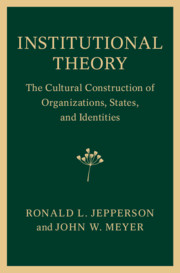Book contents
- Institutional Theory
- Institutional Theory
- Copyright page
- Contents
- Figures
- Preface
- Credits
- Part I Introduction
- Part II Institutional Theory: Its Role in Modern Social Analysis
- 2 Society without Culture:
- 3 Institutions, Institutional Effects, and Institutionalism (1991)
- 4 The Development and Application of Sociological Neoinstitutionalism (2002)
- 5 Reflections on Part II:
- Part III The Institutional Level of Analysis
- Part IV Institutions of Modernity and Postmodernity: The Construction of Actors
- Part V Conclusion
- Index
- References
2 - Society without Culture:
A Nineteenth-century Legacy (1988)
from Part II - Institutional Theory: Its Role in Modern Social Analysis
Published online by Cambridge University Press: 22 March 2021
- Institutional Theory
- Institutional Theory
- Copyright page
- Contents
- Figures
- Preface
- Credits
- Part I Introduction
- Part II Institutional Theory: Its Role in Modern Social Analysis
- 2 Society without Culture:
- 3 Institutions, Institutional Effects, and Institutionalism (1991)
- 4 The Development and Application of Sociological Neoinstitutionalism (2002)
- 5 Reflections on Part II:
- Part III The Institutional Level of Analysis
- Part IV Institutions of Modernity and Postmodernity: The Construction of Actors
- Part V Conclusion
- Index
- References
Summary
The post-Enlightenment evolution of models of national society and state.The development of ideas of individual and collective actorhood, and the corresponding peripheralization of the concept of culture.
- Type
- Chapter
- Information
- Institutional TheoryThe Cultural Construction of Organizations, States, and Identities, pp. 27 - 36Publisher: Cambridge University PressPrint publication year: 2021

